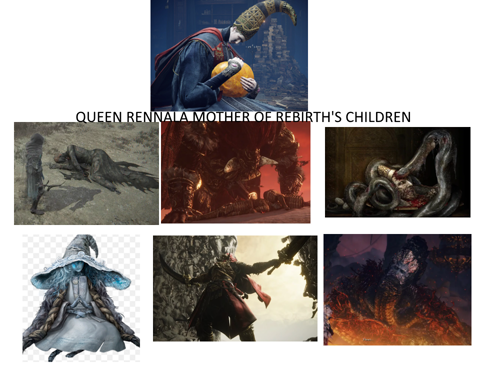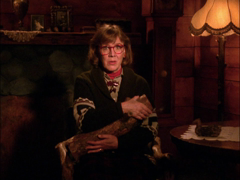"I carry a log--yes. Is it funny to you? It is not to me. Behind all things are reasons. Reasons can even explain the absurd. Do we have the time to learn the reasons behind the human being's varied behavior? I think not. Some take the time. Are they called detectives? "Watch--and see what life teaches."
There's a lot that can be said about the metanarratives in Twin Peaks. Most infamously, if there is one or not. I'm not knowledgable enough to come to a conclusion on that topic, but what I do what to focus on, to start, are the similarities between the work of David Lynch and that of FromSoftware.
First, the auteur nature prescribed to them. While there is no doubt that David Lynch and Hidetaka Miyazaki are known for being more hands-on than the average director in their fields, I personally don't like how easily some attribute anything to a singular person. Miyazaki specifically is very often quoted in interviews trying to take the attention away from himself and describing the works of his studio as a full group effort, and from interviews it is clear that he is not the sole writer nor only creative mind that is contributing -- most notably shown in the Design Works interview for Dark Souls. Because of this I want to be careful not to prescribe any idea or thread of ideas to one person, as it is nearly impossible to know for sure in most scenarios.
Secondly, the ambiguity and the desire for the audience to draw their own conclusions is shared, "...This whole section of the game is somehow a blend of memory and ongoing experience, past and present. Miyazaki has said in interviews that his games have information intentionally left out so that an unambiguous linear narrative is impossible to construct, forcing players to engage with their own imaginations... Video games more generally require their audiences to participate in telling the story. If you never touch the controller, no story happens. It's also common for video games to have multiple endings. Despite all this, FromSoftware fans are intent on identifying single canonical interpretations of each game's story, spending a lot of mental energy searching for plot linkages that carry no meaning. In film and literary analysis, interpretation is the norm, despite those media being less interactive..." -SmB
The thing is, there actually is a very straightforward premise & story usually; it's just that the closer you look the more you find shifting sand that all of it is built upon where capital 'T' Truth is impossible to know for sure (much like on earth). Elden Ring's historical depth is staggering, and one aspect of the often surprising accuracy of its history is the lost history in the game that reflects the real world's lost knowledge, "...because it could also be the Gloam Eyed Queen- we just don't know, we just don't know, and I don't think we'll ever know, and I don't think that that's the point. I don't think the point is for us to know, and that sucks because I want to know so bad, but I know that has nothing to do with, like, the central themes of like, spiritual suffering." -Xingenue.
And finally, the idea of inspiration 🐟. With it being one of the most subtle and elusive parts of a creative process it is extremely difficult to assign for sure what parts of a work were inspired by what - in what way were they inspired - and how much the artist is using that inspiration as a reference point -- especially when so many artists are working in collaboration. An artist friend of mine put it like this, "Elden Ring doesn't make sense. George's written story likely made sense but Miyazaki loves theme and aesthetics too much and twisted it all around - Hidetaka is maybe less of a great story teller and more of a great joiner of ideas, encouraging artists to follow inspiration so it appears very disjointed and scattered across the game, but the art is very inspired."
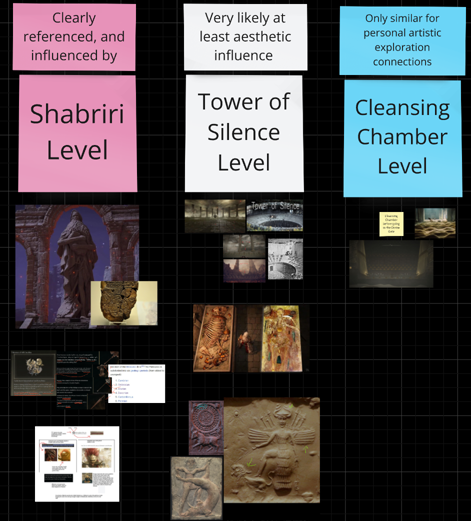
I think we can put inspiration into three broad categories with very fuzzy lines between them. The first being that which has been clearly referenced and influenced. Examples include Shabriri, The Babylonian Map of the World, the Crucible eras from Devonian, Silurian, and Ordovician, and the Nordic references with the Valkyrie & Freyja.
However, where the blurred lines come in is when the authorial intent of a piece of inspiration is unknown, whether it is to be just an aesthetic influence, or meant to convey something else. This comes up very often such as whether or not the aesthetic similarities between Farum Azula/Jagged Peak is meant to evoke the Zoroastrian Towers of Silence and if that is meant to imply air burial with the deathbirds.
To continue with this, there are many instances where a possible influence may just be coincidence. For example, the various depictions of Divine Beasts in Elden Ring share similarities with countless religious and mythic entities around the world from the Bull of Heaven of Mesopotamia, to the Barong of Bali.
To take this further, there are things where there is most likely not a reference or inspiration at all, but nonetheless add to the personal experience through connecting them. For instance, the similarities between The Cleansing Chamber & Tarkovsky's Stalker (1979). Along with this, we can make connections and extensions to things that do not even exist: the many joys of headcanon.
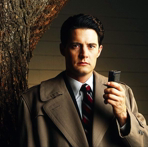
With all of this in mind, I want to go forward with the mindset that finding the "Truth" is a futile effort, and that the following is a collection to log any findings that may aid in the detective work of our investigations (whatever the detectives' goals may be). As Margaret said, "So now the sadness comes--the revelation. There is a depression after an answer is given. It was almost fun not knowing. Yes, now we know. At least we know what we sought in the beginning." So, let's enjoy our ignorance while we still can.
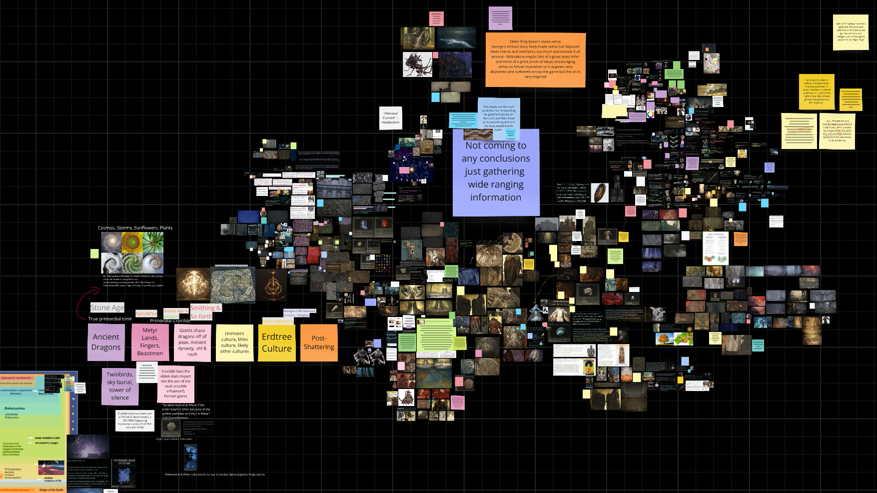
Like so many others, I've fallen into the great consuming joy of a Miro board in my investigations. I first started off with the earnest goal of lining up a canonical timeline, but when there became too many contradictions, empty spaces, and lack of explicit time frames, I let go of it and just tried to gather any information to link together.
One of the main things I focused on was the hotly discussed topic upon the release of Shadow of the Erdtree: whether or not Radahn was willing or charmed to be Miquella's consort. This is the sort of crux that is a great example of so many other mysteries. First, that this is mostly unimportant, which is not necessarily a bad thing, but is something to keep in mind. In comparison to the emotional and spiritual aspects of Miquella & St. Trina's story that holds much more depth and personal meaning, this minor question is fun to try to unravel, but if either case is found to be true, there would not be much 'nourishment' to be gained. Secondly, it's a good example of other cases as we really can't know what's canon for sure. We can be pretty sure, but the Truth is not outright stated - we have to fill in the blanks. So, what is there?
From here, I want to continue a very proper explanation, but I've lost the spark of energy I started writing all this out with, so until I get it back I'll just scatter out pieces of evidence
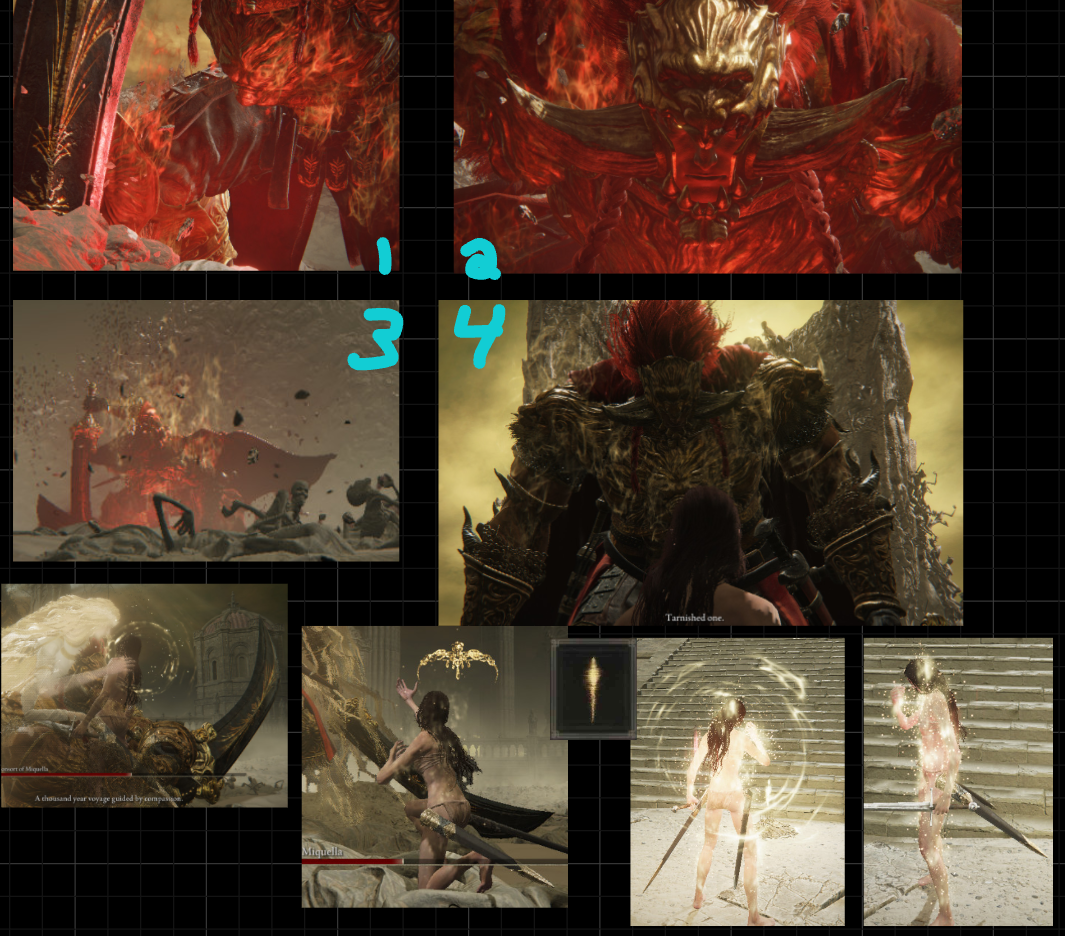
This piece of evidence shows the phase 2 transistion wherein Radahn begins to glow red, then we hear a sound from the divine gate and as Miquella's light arrives, the flames turn gold. Additionally, the Heart Stolen animation has an intereting reused asset (which is hard to know whether it is trying to show a connection or if they just smartly reused the animation asset as they often do) where it appears like the Memory of Grace item.
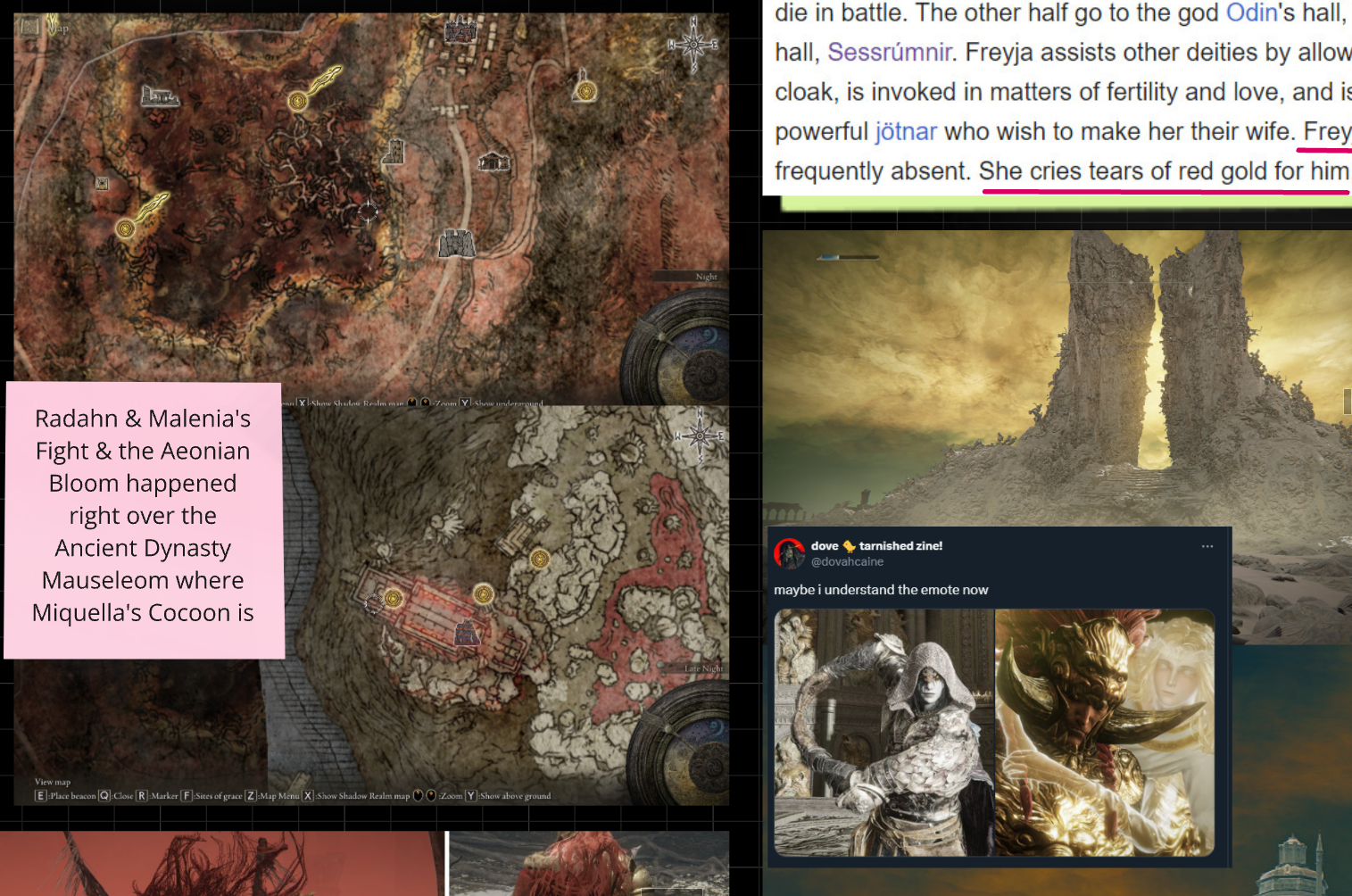
The site of Malenia's bloom is right above the Mohgwyn Dynasty where Miquella is now in a cocoon. Malenia the Valkyrie (Beautiful allusion with a guider of dead souls and being associated with rot). Malenia marching from the Haligtree through all the kingdoms all the way specifically to Caelid not trying to take over anyone else (beating Godrick without a sweat, but not taking his kingdom, nor great rune). Freyja, also of Norse myth for the afterlife.



